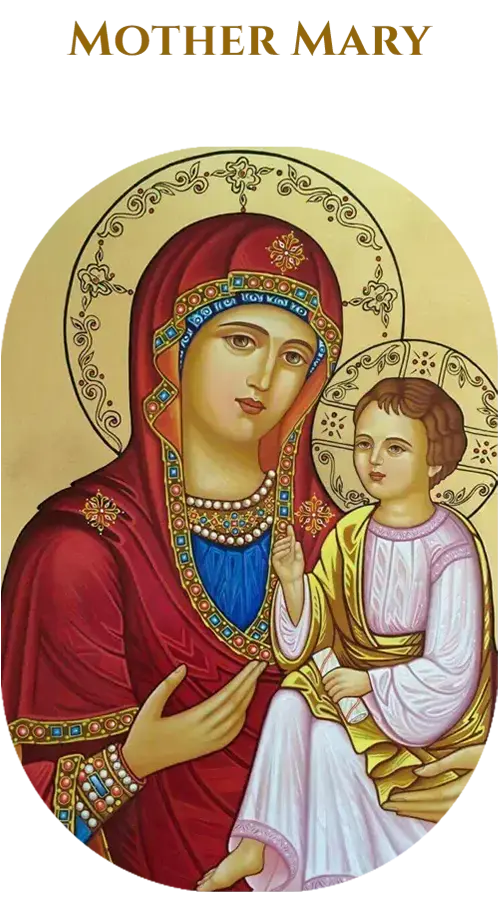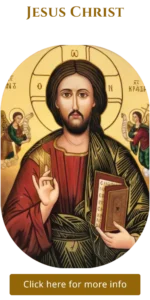Windows
- image from Mr.Salvis
Inside Paintings - East Altar
Orthodox image of Mother Mary

Introduction
In the Syrian Orthodox tradition, Mother Mary, known as the Theotokos (Greek for “God-bearer”) or Mart Maryam in Syriac, holds a central and revered place as the mother of Jesus Christ, the Incarnate Word of God. The Malabar Independent Syrian Church (MISC), which adheres to the West Syriac Rite and shares theological roots with the Syrian Orthodox Church, venerates Mother Mary in a manner consistent with Oriental


Theological Significance
• Theological Foundation: Icons of Jesus Christ are considered “windows to heaven,” not mere artworks but sacred representations that convey the reality of the Incarnation – Christ as fully divine and fully human. In the Syrian Orthodox tradition, icons are venerated (not worshipped) as a means of connecting with the divine presence, rooted in the theology of the Council of Chalcedon (451 CE) and earlier councils that affirmed Christ’s dual nature.
• Common Depictions:
– Christ Pantocrator (“Ruler of All”): One of the most prevalent images, showing Christ enthroned or standing, holding the Gospel book in one hand and blessing with the other. His face is serene yet authoritative, with large, expressive eyes symbolizing divine omniscience. The halo around His head often contains a cross and the Greek letters “IC XC” (Jesus Christ).
– Christ the Savior: Depicts Jesus with a compassionate expression, often with a golden or radiant background, emphasizing His role as Redeemer. This icon is common in churches and homes.
– Crucifixion: Shows Christ on the cross, often with the Virgin Mary and St. John the Evangelist at His sides, highlighting His sacrifice. The Syrian Orthodox style may include Syriac inscriptions and a focus on Christ’s triumph over death rather than suffering alone
– Nativity and Baptism: Icons of Christ’s birth and baptism in the Jordan are prominent during liturgical feasts, emphasizing key moments in His earthly life.
– Theotokos with Child: Christ is frequently depicted as an infant or child in the arms of the Virgin Mary (Mart Maryam), underscoring His humanity and her role as Theotokos (God-bearer).
– Artistic Style: Syrian Orthodox icons are characterized by
1. Byzantine Influence: Stylized, non-naturalistic forms with elongated figures, large eyes, and minimal perspective to convey spiritual rather than physical reality.
2. Syriac Elements: Use of Syriac script for inscriptions, vibrant colours (gold, red, blue), and symbolic motifs like the mandorla (almond-shaped aura) around Christ
3. Materials: Icons are typically painted on wood, sometimes adorned with silver or gold, and placed in churches or homes for veneration
Liturgical Role
In the Syrian Orthodox Church and the MISC, Mother Mary is commemorated extensively in the liturgical calendar and worship practices:
• Feast Days: Several feasts honour Mother Mary, including:
– Annunciation (Subbara): Celebrated on March 25, marking the angel Gabriel’s announcement to Mary of Christ’s birth.
– Nativity of Mary: Observed on September 8, commemorating her birth.
– Dormition (Shunoyo): Celebrated on August 15, honouring Mary’s falling asleep and assumption into heaven. In the Syrian tradition, the term “Dormition” emphasizes her peaceful passing rather than a bodily assumption, though her heavenly glorification is affirmed.
– Presentation of Mary in the Temple: Celebrated on November 21, recalling her dedication to God as a young girl.
– Other feasts include commemorations of Mary as the patroness of various churches and events tied to her life.
• Liturgical Hymns and Prayers: The Syrian Orthodox liturgy includes numerous hymns (qole) and prayers dedicated to Mary, often found in the Fenqitho (the liturgical book). For example, the hymn “O Virgin Mother” praises her as the “second heaven” who bore the Savior. The MISC, sharing this liturgical tradition, incorporates similar hymns in its West Syriac Rite services.
• Daily Prayers: Mary is invoked in the Shehimo (daily prayers), particularly in the evening and morning services, where her intercessory role is emphasized. For instance, the prayer “O Virgin Mother, protect us” is common in Syrian Orthodox devotion.
Iconography and Devotion
• Icons: Mother Mary is depicted in icons, often as the Theotokos holding the Christ Child, symbolizing her role as the bearer of God. These icons are venerated in churches and homes, serving as focal points for prayer and meditation. In MISC churches, such as St. Mary’s Church at Perumannoor, her iconography is prominent.
• Titles and Epithets: Mary is addressed with titles like “Mother of God,” “Queen of Heaven,” “Star of the Sea,” and “Mother of Mercy” in Syriac hymns and prayers, reflecting her multifaceted role as a divine mother and intercessor.
• Popular Devotion: Devotees often offer prayers, light lamps, and make vows in her honour, seeking her intercession for healing, protection, and spiritual guidance. The MISC’s small community, centred in Thozhiyur and surrounding areas, maintains these practices, especially during feasts like the Dormition.
Role in the MISC Context
The MISC, as highlighted in the biographies of its Metropolitans (e.g., Paulose Mar Philoxenos III, who oversaw the completion of St. Mary’s Church at Perumannoor), places significant emphasis on venerating Mother Mary. The construction and dedication of churches named after her, such as St. Mary’s Church, reflect her importance in the MISC’s spiritual life. The church’s West Syriac Rite, inherited from the Syrian Orthodox tradition, ensures that Marian feasts and prayers are integral to worship. For example:
• The canonization of Mar Koorilose I and the 250th anniversary celebration of the MISC in 2022, as noted in Cyril Mar Baselios I’s tenure, likely included Marian devotions, given her central role in the church’s liturgy.
• The Gospel Association, supported by successive Metropolitans, organizes retreats and conventions that often incorporate prayers to Mary, reinforcing her role as a spiritual mother.
Theological and Cultural Distinctives
• Non-Dogmatic Approach to Assumption: Unlike the early Church, which dogmatically defines the Assumption of Mary (1950), the Syrian Orthodox tradition (and by extension, the MISC) celebrates the Dormition without mandating belief in her bodily assumption. The focus is on her glorification in heaven and her ongoing intercessory role.
• Ecumenical Perspective: The MISC’s ecumenical engagements, as seen in the tenures of Joseph Mar Koorilose IX and Cyril Mar Baselios I, extend to Marian devotion. While maintaining Orthodox traditions, the MISC’s interactions with Anglican and other churches show openness to shared veneration of Mary, as evidenced by joint Eucharistic celebrations where Marian hymns may be included.
• Cultural Resonance: In Kerala’s Saint Thomas Christian community, Mary’s role resonates deeply, with her feasts drawing large gatherings and local traditions like processions and offerings during her feasts.
Legacy and Contemporary Relevance
Mother Mary’s significance in the Syrian Orthodox tradition, as practiced by the MISC, remains vibrant under the leadership of Cyril Mar Baselios I (2001–present). Her intercessory role is invoked in times of crisis, as seen in the MISC’s social advocacy efforts, such as Cyril Mar Baselios I’s 2025 protest against systemic oppression, where spiritual appeals often include Marian prayers for justice and protection. The MISC’s churches, such as St. Mary’s at Perumannoor, serve as centers for Marian devotion, fostering community unity and spiritual resilience.



